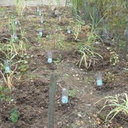Copper stress-induced changes in leaf soluble proteome of Cu-sensitive and tolerant Agrostis capillaris L. populations.
Märksõnad
Abstraktne
Changes in leaf soluble proteome were explored in 3-month-old plants of metallicolous (M) and nonmetallicolous (NM) Agrostis capillaris L. populations exposed to increasing Cu concentrations (1-50 μM) to investigate molecular mechanisms underlying plant responses to Cu excess and tolerance of M plants. Plants were cultivated on perlite (CuSO4 spiked-nutrient solution). Soluble proteins, extracted by the trichloroacetic acid/acetone procedure, were separated with 2-DE (linear 4-7 pH gradient). Analysis of CCB-stained gels (PDQuest) reproducibly detected 214 spots, and 64 proteins differentially expressed were identified using LC-MS/MS. In both populations, Cu excess impacted both light-dependent (OEE, cytochrome b6-f complex, and chlorophyll a-b binding protein), and -independent (RuBisCO) photosynthesis reactions, more intensively in NM leaves (ferredoxin-NADP reductase and metalloprotease FTSH2). In both populations, upregulation of isocitrate dehydrogenase and cysteine/methionine synthases respectively suggested increased isocitrate oxidation and enhanced need for S-containing amino-acids, likely for chelation and detoxification. In NM leaves, an increasing need for energetic compounds was indicated by the stimulation of ATPases, glycolysis, pentose phosphate pathway, and Calvin cycle enzymes; impacts on protein metabolism and oxidative stress increase were respectively suggested by the rise of chaperones and redox enzymes. Overexpression of a HSP70 may be pivotal for M Cu tolerance by protecting protein metabolism. All MS data have been deposited in the ProteomeXchange with the dataset identifier PXD001930 (http//proteomecentral.proteomexchange.org/dataset/PXD001930).


